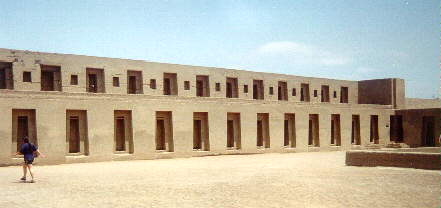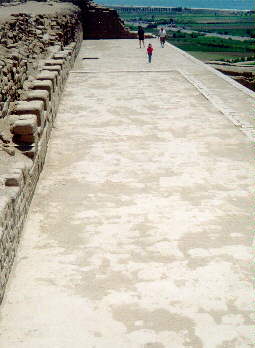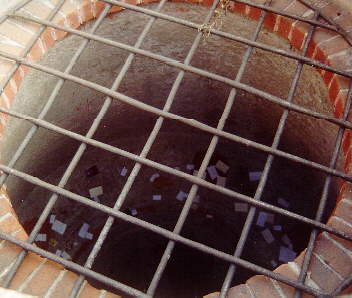
Pachacámac - Aqlla Wasi

During my stay in Lima, people kept asking me whether I had seen, or would see, Machu Picchu. I haven't time, I would reply wistfully. Perhaps next year. They would suggest, almost by way of offering a consolation prize, that I visit Pachacámac.
Pachacamac is not the most impressive ruin in Peru but it is certainly worth the visit, if for no other reason than its proximity. Of the half-dozen or so huacas around Lima it is the most extensive. It was an important administrative and ceremonial center. It had existed before the Incas and saw several dynasties come and go.
After a short stop in Lurín to sample the town's famous chicharrón, we proceeded to the dusty, windswept mesa where the ruins were located. The guards told us to hurry, it was New Year's Eve and they wanted to get home early. Due to the lack of time and the heat we decided to drive the 3 kM circuit. We climbed the 130-foot pyramid used by the Inca to encourage worship of the sun among the locals. The pyramid itself is at the top of 370-foot promontory, affording a spectacular view of the Lurin valley and the ocean.

Pachacámac - Aqlla Wasi
The aqlla wasi was the latest addition to the complex, built during the times of the Inca, and home to a convent of "elect women". The aqlla wasi was laboriously restored in the 1930s, but is now falling victim to graffiti vandals, who find the soft adobe an ideal surface for carving names. The trapezoidal niches, characteristic of Inca architecture, were said to house idols, guardians of the elect women. I stopped to picture the wall replete with the guardian idols, staring silently over the open plaza.
But we were too busy completing the walk and taking photographs to contemplate what we were seeing. We finished the circuit and returned home. Later at the house I began to wonder. What kind of ceremonies were realized at the top of the great pyramid? What prayers were offered from this sacred place? To what deity did the denizens of the Aqlla Wasi dedicate themselves? I thought of Pachacuti Yamqui Salcamaygua's prayer of Viracocha:
A, Wiraquchan, t'iqsi qhapaq,
Kay qhari kachun, kay warmi kachun, ñiq apu,
Hinatin chichha kamaq, maypim kanki?
Manachu rikuykiman?
O Viracocha, Lord of the beginning,
Lord who said "Let there be man, let there be woman."
Creator of all, where are you?
Might I not see you?
I knew the prayer was a postcolumbian invention, an attempt to explain the God of the Bible in terms that the native Peruvians might understand. But the words were still evocative.
Pachacuti Yamqui Salcamaygua wrote the Relación de antiguedades deste reyno del Piru which, together with the famous writings and drawings of Guaman Poma and the documents of Huarochirí, give us a faint glimpse of life in Peru before the conquest. This enigmatic document relates the history of the Inca empire in a highly mythologized style. The author goes as far as to alter this history to accomodate the Christian religion within the context of ancient belief systems. The prayer to Viracocha, in particular, more accurately describes the Unknown God talked about by Saint Paul in Athens, than any of the Peruvian deities. But the prayer, the pyramid at Pachacamac, the many churches and convents in Lima, all testify to the intense desire of men and women to experience the divine. No doubt, Pachacuti was searching, too.
Centuries later, another Peruvian, Isabel Flores de Oliva, also sought her God. So fervent was her desire for communion with the Almighty that she engaged in all sorts of acts that seem incomprehensible today: she built a 4 x 5-foot cell in which to pray, wore a spiked crown, whipped herself, and engaged in other similar penances. She became a Dominican Tertiary (St. Martin of Porres, who lived at the same time, was a member of that order and is also greatly venerated in Lima.), worked in the community, and founded a convent dedicated to St. Catherine of Siena. Through her intercessions, Lima and Callao were spared an onslaught by the Dutch. She was canonized only a half-century after her death and is considered the patroness of the Americas.
 The house were her family lived
was preserved, and later converted into a sanctuary with chapels,
a garden, and souvenir sellers.
Although a vital refuge from the bustle of modern Lima, the sanctuary
was not spared urban assault; the twin towers that graced the
entrance were lost
with the widening of the Avenida Tacna. The lemon tree where the devil
hid to tempt the saint had been reduced to splinters by the
faithful. But much remains as it
was centuries ago. Visitors still write petitions to the saint and
drop them into the well where she hid the keys
to her chastity belt. The well is over 60 feet deep and is said to
be very nearly full with petitions from over the centuries.
The house were her family lived
was preserved, and later converted into a sanctuary with chapels,
a garden, and souvenir sellers.
Although a vital refuge from the bustle of modern Lima, the sanctuary
was not spared urban assault; the twin towers that graced the
entrance were lost
with the widening of the Avenida Tacna. The lemon tree where the devil
hid to tempt the saint had been reduced to splinters by the
faithful. But much remains as it
was centuries ago. Visitors still write petitions to the saint and
drop them into the well where she hid the keys
to her chastity belt. The well is over 60 feet deep and is said to
be very nearly full with petitions from over the centuries.